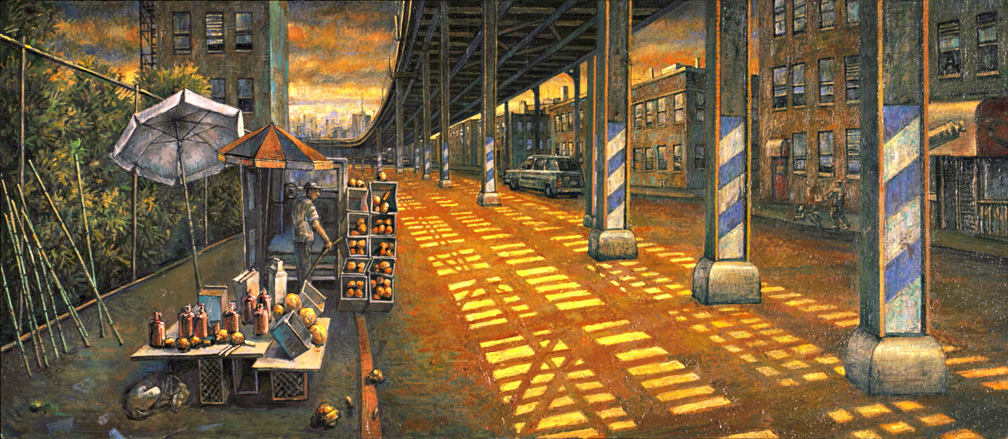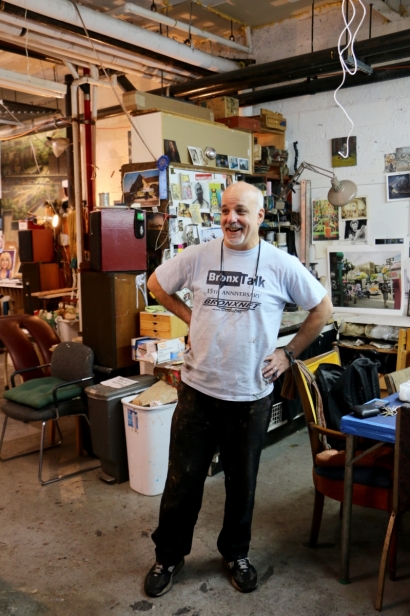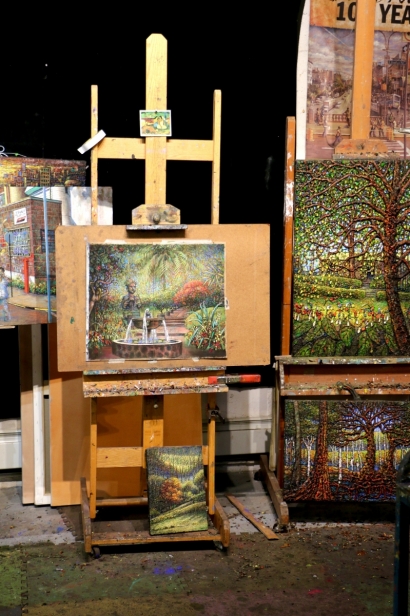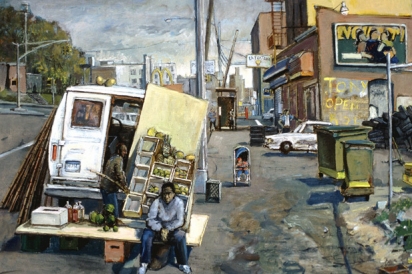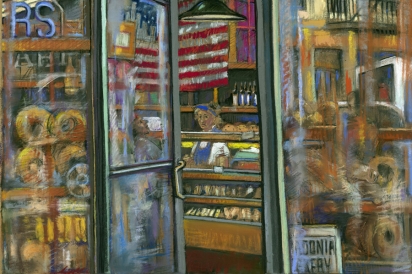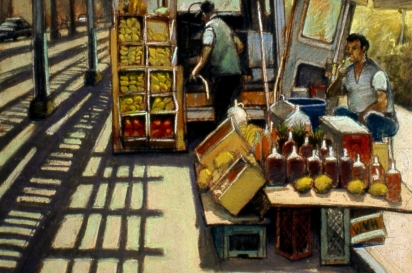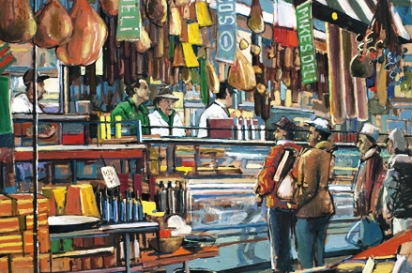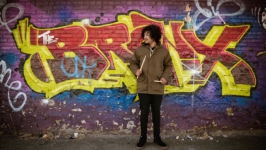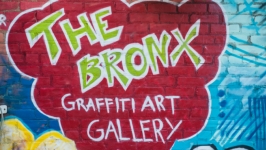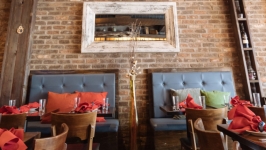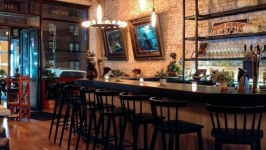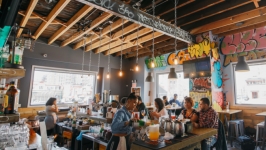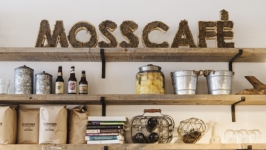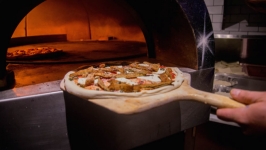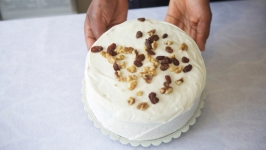The Bronx Provides Inspiration And Community For Painter Daniel Hauben
Daniel Hauben grew up at the intersection of Boston and Eastchester Road in an apartment complex known as the Hillside Homes. “In the mid-’60s there was [the] beginning of changes in the neighborhood and gang action and my mother discovered syringes on the roof,” he recalls. “It was time to move.”
Shortly after, his family relocated to Kingsbridge Heights in the North West Bronx. Suiting its name, the neighborhood is perched atop a rocky hill overlooking the beautiful urban valley extending into Riverdale. “This view was a very captivating view for my young brain … and it’s the view I am most connected with.” The vast, multi-dimensional concrete sprawl of Kingsbridge remained central to his character and remains a constant source of inspiration.
Hauben has been painting the Bronx for over 40 years, and he’s experienced it all, “from the art deco days to the graffiti days and the burnt-out Bronx days,” he says. His work seizes the everyday beauty of his underappreciated and largely undocumented borough and has been exhibited everywhere from the Bronx Museum all the way to the Galerie Magnificat in Berlin, Germany. He has painted on location throughout the Bronx: 161st Street, East 149th Street (the Hub), Arthur Avenue, Kingsbridge, the Grand Concourse, Loews Paradise Theatre and more.
A visit to his studio in Riverdale reveals many of his best-known pieces. He calls himself a “closet surrealist,” whose work ranges widely from his black window series of warped, ominous urban landscapes to his less foreboding, nonetheless surreal, Bronx landscape paintings. All the while, he reflects a constant goal of capturing the unique feeling of the Bronx.
Hauben’s largest piece measures 22 feet long, a painting of the view from his Kingsbridge Heights apartment. The painting was started on its leftmost panel as a self-portrait, accompanied by a view into his living room, where his wife, Judy, is loading a record. The painting expands from this one panel to capture a panoramic view. By including his domestic world, himself and the objective world around him all in one painting, he captures the full experience of urban life.
Despite the accuracy, detail, and refinement Hauben captures, he takes pride in the simultaneously gritty, funky style of painting. Incorporated throughout his art pieces are “tidbits” from various other works, including an etching by John Sloan of a couple, “Sunbathers on the Roof,” 1941. The couple was “transplanted” from their Manhattan roof in 1941 onto a rooftop in Hauben’s work, again shedding light on Hauben’s unique style. The painting is continuously being added to, as if it’s a living breathing, evolving work, not unlike the Bronx itself.
Like his paintings, Hauben’s life has been untraditional, to say the least. In 1971, his face was “smashed in” by police during an anti-Vietnam War protest in Washington, DC, resulting in two black eyes that he boasted after returning to his junior high school. Dan attended Music and Art (LaGuardia High School) for one year and decided to drop out. Shortly after, he flew to Kathmandu, Nepal, traveling across Northern India for four months, contracting severe hepatitis and after returning home, he proceeded to hitchhike across America. He later worked for the Department of Social Security in the World Trade Center and the midnight shift at the Bronx General Post Office. He then entered the School of Visual Arts, getting his GED one year before he would’ve graduated, had he remained in high school. Since then, he has taught at the Bronx Regional High School. He currently teaches part-time at the Riverdale Y and City College, instructing the elderly and architecture students, respectively. Evidently, Hauben never had a plan. He was the fifth of five well-accomplished children and largely thanks his parents for enabling his nontraditional path in life. After living in Boston from 1975 to 1980, Hauben returned to the same apartment he grew up in, reclaiming his view of Kingsbridge. He remains there to this day with his wife.
“The Bronx is a unique environment,” he says. “It’s unique to New York City in how new it is. It’s different than Manhattan or Brooklyn in that we were the last frontier … even when I was a kid there was a goat farm on Gun Hill Road and chicken farms.”
Hauben’s documentation of the Bronx is not limited to painting. The Bronx Artist Documentary Project (BxADP), a book spearheaded by Hauben, sought to uncover and unite the Bronx art community. For decades, the Bronx has been divided into a multitude of neighborhoods, its many artists divided as well. The goal of the project was to “connect the dots,” as he puts it, between the borough’s art community. Hauben and his colleagues documented over 82 artists from ages 19 to 93 in the book, published in 2014.
Hauben is a driving force in uniting and shedding light on the diverse artist community within the Bronx. Perhaps in a few decades, if not already, Daniel Hauben’s name will be inseparable from the urban, exciting, beautiful landscape of the Bronx. He’s hopeful for the future of the borough’s art community, noting “with a little bit of encouragement and a little bit of funding, the Bronx, in a heartbeat, would be the mural capital of the planet.” Much of his hope can be traced back to his own efforts to find, capture and spread the beauty of the Bronx.
Dan’s favorite neighborhood spot?
Nagoya Sushi Restaurant on Mosholu Avenue. It is a quiet, unpretentious, reasonably priced sushi spot—plus, it has no TV. His wife loves the Spicy Titanic Roll and he prefers the Nabeyaki udon.
His favorite pizza place?
Pugsley’s Pizza on East 191st. He notes that their Love Pie, chicken wings and homemade hot sauce are unparalleled. Dan’s work is featured on the ceiling.
Favorite neighborhood staple?
Riverdale Bagels on Riverdale Avenue. His “usual” consists of two eggs with Swiss on an everything bagel


